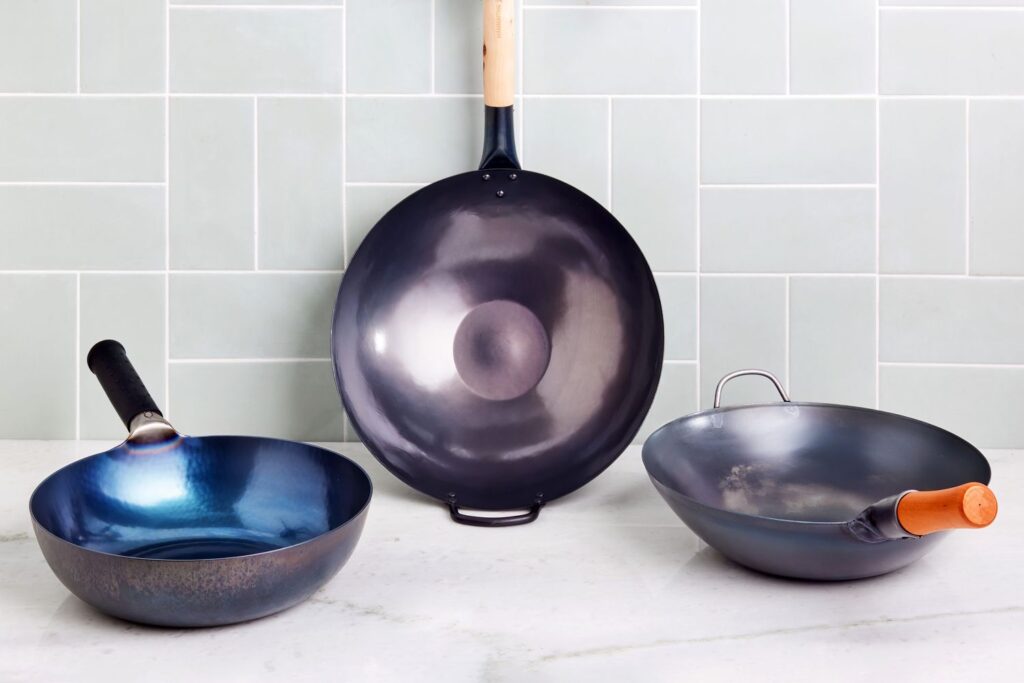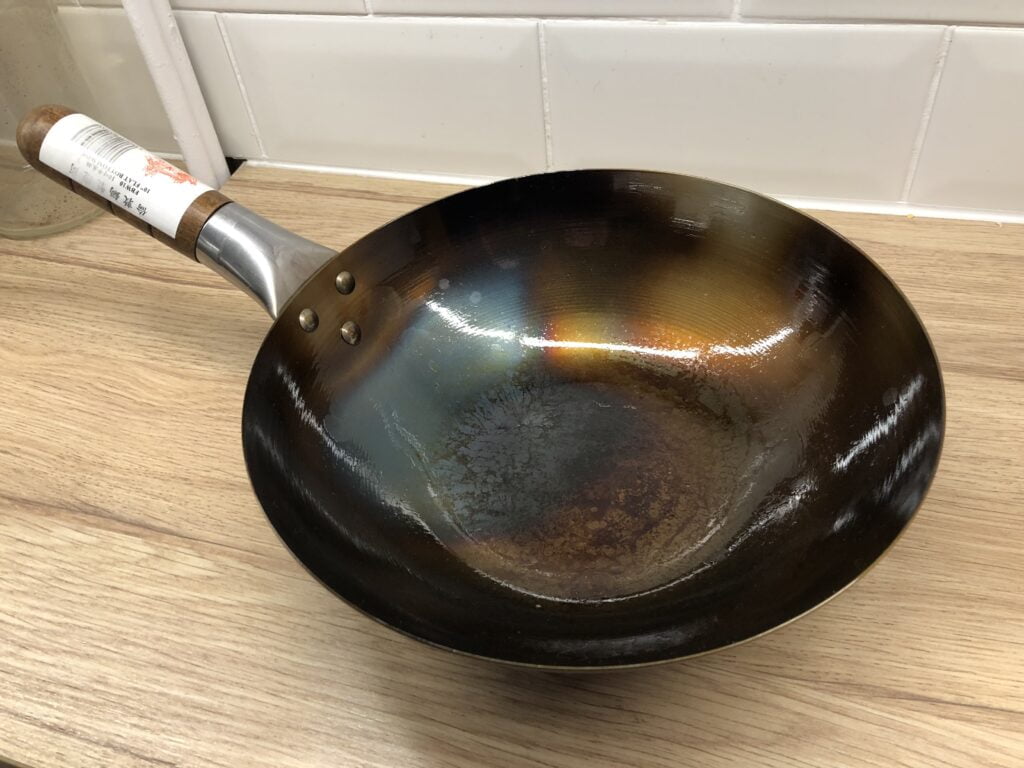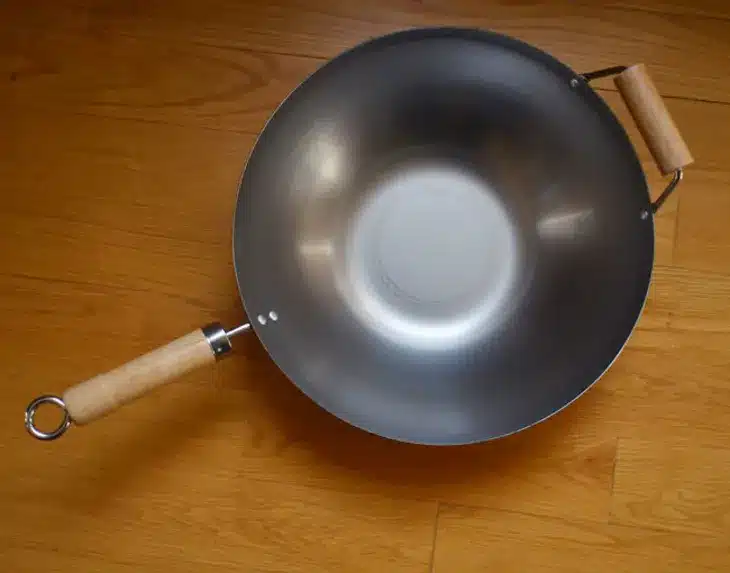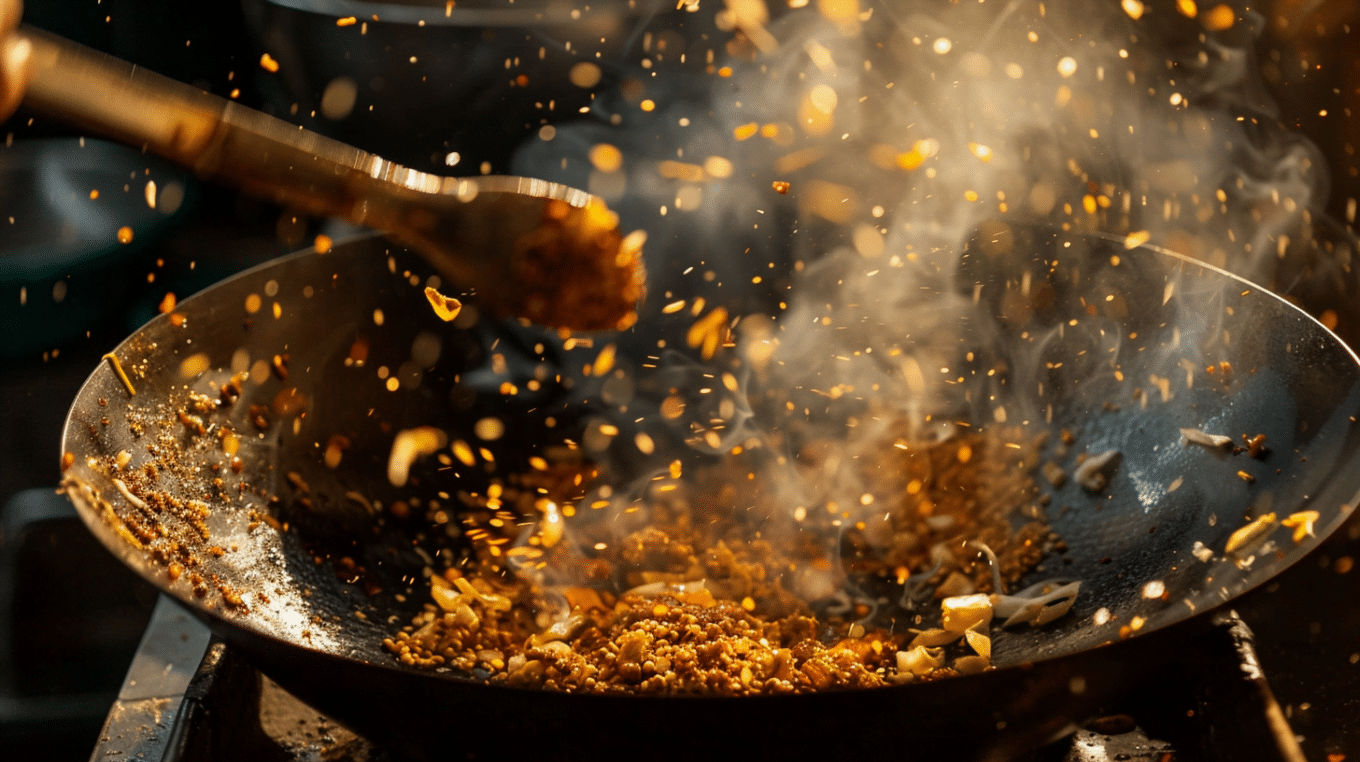Seasoning your wok is crucial for creating delicious stir-fries and ensuring your pan lasts for years.
However, choosing the right one can be overwhelming with so many seasoning techniques.
If you’re tired of food sticking to your wok or struggling to achieve that perfect flavor, don’t worry!
In this guide, we’ll explore different wok seasoning methods, making it easy for you to find the ideal technique for your cooking style and preferences.
Whether a beginner or a seasoned pro, you’ll discover the best way to season your wok, ensuring every meal succeeds.
Say goodbye to the hassle and hello to delicious, perfectly cooked stir-fries every time!
Overview of Wok Seasoning
Wok seasoning involves applying a thin layer of oil to the inside of the wok and heating it until a protective, non-stick surface forms.
This process is crucial because the heated oil bonds with the metal, filling small surface pores.
It results in a naturally non-stick surface, simplifies cooking, and prevents rust, which extends the wok’s lifespan.
- Enhanced Flavor: Seasoned Woks impart a smoky flavor to dishes, adding depth and complexity.
- Non-Stick Surface: The oil layer acts as a natural non-stick coating, requiring less oil and reducing food adhesion.
- Rust Prevention: The protective oil layer prevents moisture buildup, protecting the wok from rust and corrosion.
Different Wok Materials and Their Seasoning Needs

Woks are available in several materials, each requiring specific care and seasoning techniques.
1. Carbon Steel
- Carbon steel is a traditional material that requires initial and regular seasoning to develop a non-stick patina.
- Its lightweight design makes it responsive to heat changes, which makes it ideal for stir-frying.
- Regular oiling helps maintain its patina.
2. Cast Iron
- Cast iron heats up slowly but retains heat exceptionally well.
- It requires thorough seasoning to prevent rust and establish a non-stick layer.
- Avoid soaking cast iron in water and dry it thoroughly.
3. Stainless Steel
- Stainless steel woks are low-maintenance and don’t need traditional seasoning.
- Occasional oiling can enhance their non-stick properties.
- These Woks are suitable for those who prefer low-maintenance options.
4. Non-Stick
- Non-stick woks don’t need seasoning because of their pre-applied coating.
- However, it’s important to avoid abrasive utensils and sponges that can scratch the surface.
- Use soft cleaning tools and dry thoroughly to avoid rust.
Detailed Steps for Seasoning Based on Material
1. Carbon Steel and Cast Iron

- Clean: Scrub the wok with hot water to remove any residue.
- Dry: Dry the wok over low heat to eliminate moisture.
- Apply Oil: Coat the interior with high-smoke-point oil using a paper towel.
- Heat: Let the oil smoke over medium-high heat, and the wok darken.
- Cool and Repeat: Allow the wok to cool and remove excess oil.
Repeat this process 2-3 times.
2. Stainless Steel

- Clean: Wash the wok with warm, soapy water and dry thoroughly.
- Optional Oil: Lightly coat the surface with oil, then heat until it smokes.
Wipe off excess oil.
3. Non-Stick

- Avoid Abrasives: Refrain from using abrasive utensils or sponges.
- Gentle Cleaning: Clean with a soft sponge, warm water, and mild dish soap.
- Dry: Thoroughly dry before storage.
Properties of Wok Material
| Material | Properties | Care Tips |
|---|---|---|
| Carbon Steel | Lightweight, responsive to heat | Maintain the patina by regularly oiling and avoid immediate washing after cooking. |
| Cast Iron | Slow to heat, excellent heat retention | Dry thoroughly before storage to prevent rust. |
| Stainless Steel | Durable, requires minimal maintenance | Occasionally oil to enhance non-stick properties. |
| Non-Stick | Pre-coated, naturally non-stick | Use soft cleaning tools and utensils to avoid scratching the surface. |
A well-seasoned wok offers a naturally non-stick surface and enhances your cooking experience.
Following specific seasoning guidelines for the wok’s material can maximize flavor and prevent rust.
Regular maintenance will keep your Wok performing at its best, ensuring flavorful stir-fries for many years.
How to Season Using the High-Heat Method
1. Detailed Procedure
- To remove dirt or residue, thoroughly clean your wok with hot water and a scrub brush. Then, dry the wok completely.
- Place the wok on a burner over high heat until it smokes. Depending on your stovetop’s heat output, this may take several minutes.
- Once the wok is smoking, add a small amount of oil (about 1-2 tablespoons) with a high smoke point, such as peanut, canola, or grapeseed oil.
- Using a paper towel with tongs, carefully spread the oil evenly across the entire Wok surface, including the sides and up to the rim.
- Continue heating the wok until the oil smokes and the surface turns dark, golden-brown. This indicates that the oil is polymerizing and bonding to the metal.
- Remove the wok from the heat and allow it to cool slightly. Wipe out any excess oil with a clean paper towel.
- Repeat the process 2-3 times to build a strong, even patina.
2. Benefits
- The traditional high-heat seasoning method creates a strong, durable patina that is well-suited to the demands of frequent high-temperature cooking.
- This patina provides a naturally non-stick surface for easy food release and minimal sticking.
- Additionally, the patina developed through high-heat seasoning can enhance the flavor of your dishes, imparting a subtle, smoky taste characteristic of wok-cooked meals.
3. Maintenance Tips
It’s important to clean your wok properly after each use to maintain the patina created by high-heat seasoning.
- Avoid using soap or abrasive scouring pads, as these can strip away the seasoning.
- Instead, rinse the wok with hot water and use a soft sponge or brush to remove any food particles.
After cleaning, dry the wok thoroughly and apply a thin layer of oil to the surface before storing it. This will help prevent rust and maintain the seasoning.
4. Troubleshooting Common Issues
If you experience uneven seasoning or excessive smoking during the high-heat seasoning, try adjusting the heat or the amount of oil used.
- A lower heat setting or a thinner layer of oil can help reduce smoking and promote even coverage.
- Should the patina begin to wear off over time, re-season the wok using the high-heat method.
- Regular use and proper maintenance will help build and maintain a strong, long-lasting patina.
- With practice and patience, the traditional high-heat seasoning method can help you achieve a beautifully seasoned wok that will enhance your cooking and last for years.
Oven Seasoning Method for Woks
1. Detailed Procedure
- Preheat your oven to 450°F (230°C).
- This high temperature is necessary to bond the oil to the wok’s surface.
- While the oven heats, thoroughly clean your wok with hot water and a scrub brush to remove dirt and debris. Then, dry the wok completely.
- Using a paper towel, apply a thin layer of oil (with a high smoke point) to the entire surface of the Wok, including the outside and handles.
- Place the wok upside down on the middle rack of the preheated oven.
This position allows the oil to distribute evenly and prevents it from pooling at the bottom of the wok. - Bake the wok for 30-45 minutes or until the oil has formed a dark, golden-brown coating on the surface.
- Using oven mitts, carefully remove the hot wok from the oven and let it cool completely before handling.
2. Benefits
- The oven seasoning method creates a durable, non-stick surface on cast iron and carbon steel woks.
- This technique ensures an even coating of oil across the entire wok surface by using the consistent heat of an oven.
- One of the main benefits of oven seasoning is that it minimizes the amount of smoke and oil splatter compared to stovetop methods.
- This makes it a great option for those sensitive to strong odors or want to avoid a messy cleanup process.
3. Safety Tips and Best Practices
- Always use oven mitts when handling a hot wok to prevent burns.
- Ensure proper ventilation in your kitchen to avoid smoke buildup.
- Choose oils with high smoke points, such as peanut, canola, or grapeseed oil, to minimize smoking and optimize the seasoning process.
4. Maintenance After Oven Seasoning
- To maintain the seasoning on your wok, it’s essential to clean it properly after each use.
- Wash the wok with hot water and a soft sponge, avoiding harsh detergents that can strip away the seasoning.
- Dry the wok thoroughly and apply a thin layer of oil before storing it.
- Regular re-seasoning, every few months or as needed, will help keep your wok non-stick and rust-free.
- Repeat the oven seasoning process whenever you notice the seasoning starting to fade or the food beginning to stick.
5. Troubleshooting Common Issues
- If the seasoning is uneven, try applying a thinner layer of oil and ensuring the Wok is positioned upside down in the oven to promote even distribution.
- If you experience excessive smoke, switch to an oil with a higher smoke point or reduce the oven temperature slightly.
- If the seasoning attempt fails and the coating appears patchy or flakes off, scrub the wok clean with hot water and start the process again, paying close attention to the evenness of the oil application and the oven temperature.
With patience and practice, the oven seasoning method can help you achieve a beautifully seasoned wok that will serve you well for years.
Seasoning for Woks: Salt Scrubbing Method
1. Detailed Procedure
- Sprinkle a generous amount of coarse salt (such as kosher or sea salt) over the entire surface of your Wok.
- Scrub the salt around the wok in circular motions using a paper towel or soft cloth.
- Focus on rust or stuck-on food areas, applying more pressure as needed.
- To enhance the effectiveness of the salt, heat the wok slightly over low heat.
- This helps open up the pores of the metal, allowing the salt to penetrate better and remove residues.
- After scrubbing, wipe out the salt and inspect the wok’s surface.
- Repeat scrubbing if rust or food particles remain until the Wok is clean.
- Once satisfied with the results, rinse the wok thoroughly with warm water.
- Dry it completely with a clean towel.
- After salt scrubbing, it’s essential to re-season your wok to create a protective, non-stick surface.
- To do this, use a paper towel to apply a thin layer of high-smoke-point oil (such as peanut, canola, or grapeseed oil) to the wok’s surface.
- Heat the wok over medium-high heat until the oil begins to smoke and the surface turns dark, golden brown.
- This process, known as polymerization, bonds the oil to the metal, creating a durable, non-stick coating.
- For those with older Woks that have accumulated rust or stubborn food residues, salt scrubbing is an effective way to restore and maintain your cooking companion.
- This technique uses salt’s natural abrasiveness to remove build-up and prepare the wok’s surface for re-seasoning.
2. Benefits
- Effective Cleaning: Salt scrubbing is an excellent way to remove old residues and rust from your Wok, creating a clean slate for the seasoning process. The coarse texture of salt acts as a natural abrasive, effectively scraping away stuck-on food and rust without damaging the wok’s surface.
- Non-Toxic Alternative: One of the main advantages of using salt is that it’s a non-toxic, chemical-free alternative to harsh cleaners.
This makes it safer for your cookware and your health, as you won’t have to worry about harmful residues lingering on your wok’s surface.
3. Maintenance Tips
- After each use, wash your wok with hot water and a soft sponge, avoiding harsh detergents that can strip away the seasoning.
- Dry your wok thoroughly and apply a thin layer of oil to the surface before storing it in a dry place.
- This will help preserve the seasoning and prevent rust from forming.
Salt scrubbing is a highly effective way to restore and maintain older works. It removes rust and stubborn residues without the need for harsh chemicals.
Following the simple steps outlined above and practicing regular maintenance, you can keep your Wok in excellent condition for years.
Whether you’re a seasoned wok enthusiast or new to this versatile cooking tool, incorporating the salt scrubbing method into your care routine is a natural and efficient way to ensure your wok’s optimal performance.
Factors to Consider Before Choosing a Seasoning Type
1. Frequency of Use
If you use your wok regularly, you may want to opt for high-heat seasoning methods that create a durable, long-lasting, non-stick surface.
These techniques involve heating the wok to high temperatures and applying oil, which helps to build a strong patina over time.
On the other hand, if you only use your wok occasionally, a less intensive seasoning method may suffice.
2. Material Type
The material of your Wok plays a significant role in determining the best seasoning method.
- Cast Iron and Carbon Steel are ideal for traditional seasoning techniques, as they can withstand high temperatures and develop a natural, non-stick patina.
- Stainless Steel: While not requiring seasoning, stainless steel woks can benefit from light oiling to improve their performance.
- Non-Stick Woks: They may only need minimal seasoning to maintain their coating.
3. Maintenance
Consider the level of maintenance each seasoning method requires.
- Traditional seasoning techniques, such as those used for cast iron and carbon steel woks, may need periodic reapplication to maintain the non-stick surface. This involves re-seasoning every few months or as required.
- Using a commercial non-stick spray or oiling a stainless steel wok may require less upkeep.
4. Skill Level
Your level of cooking experience can also influence your choice of seasoning technique.
- Beginners: Commercial seasoning sprays or pre-seasoned woks simplify the process and reduce the risk of uneven or inadequate seasoning.
- Experienced Cooks: Manual seasoning methods offer greater control over the final result and allow for a customized non-stick surface.
Summing Up
Choosing the right seasoning technique for your Wok is essential to ensure optimal performance and longevity.
Whether you opt for the convenience of commercial seasoning solutions, the restorative power of salt scrubbing, the even coating of oven seasoning, or the durability of traditional high-heat seasoning, the key is to find a method that suits your cooking style and preferences.
By considering factors such as frequency of use, wok material, maintenance requirements, and your skill level, you can make an informed decision and achieve a beautifully seasoned wok that will enhance your cooking experience.
Remember to maintain your wok with proper cleaning and regular re-seasoning to preserve its non-stick properties and prevent rust. With the right seasoning technique and a little care, your Wok will be a reliable kitchen companion for years.




